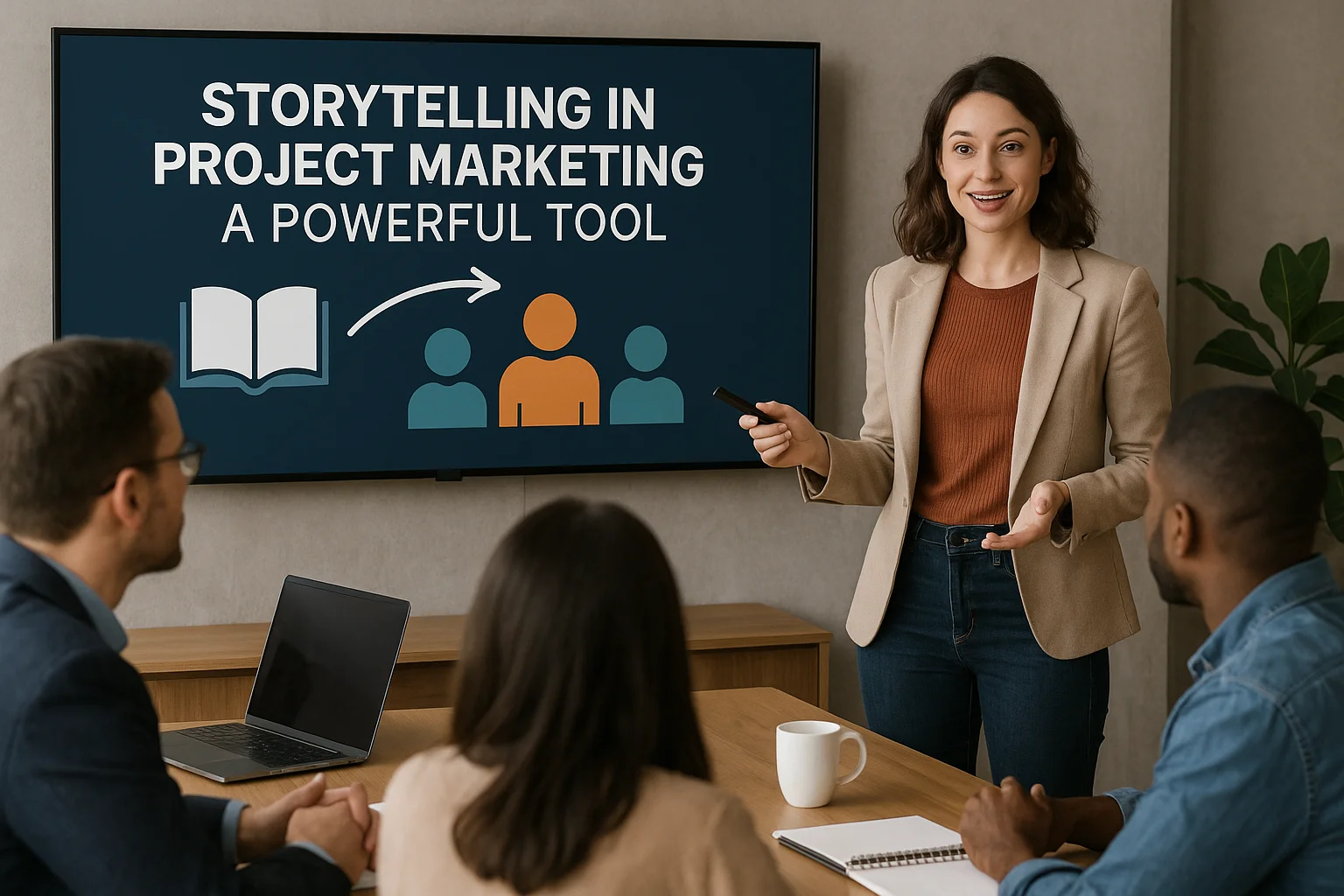The Power of Storytelling in Project Marketing

Why Storytelling Matters in Project Marketing
In project marketing, facts and roadmaps alone rarely persuade. A clear narrative turns timelines, budgets, and features into meaning. A well-structured story helps audiences grasp why the project exists, who it helps, and what changes once it succeeds—accelerating buy-in, funding, and adoption.
It Translates Complexity Into Clarity
- From specs to sense: Stories connect milestones and deliverables to outcomes people care about (efficiency, safety, growth) so decisions feel obvious.
- Context before detail: A narrative arc (challenge → action → result) allows stakeholders to understand the bigger picture before diving into technical specifics.
It Builds Emotional Connection
- Shared purpose: When people see themselves reflected in the story, they feel personally invested in the project’s success.
- Emotions drive memory: Data may be forgotten, but stories create moments that stick, making communication more persuasive and lasting.
It Strengthens Stakeholder Alignment
- Unifying message: A common narrative prevents misunderstandings between teams, investors, and clients by aligning them around a single vision.
- Motivation through meaning: Beyond goals and KPIs, stories explain the “why” behind the project, which fuels long-term commitment and collaboration.
The Psychology Behind Storytelling
Stories resonate because they are deeply connected to how the human brain processes information. Instead of analyzing fragmented data, the brain naturally seeks patterns, cause-and-effect relationships, and emotional meaning. This makes storytelling not only a communication technique but also a psychological necessity.
How the Brain Responds to Stories
- Activation of multiple brain regions: When listening to a story, areas linked to language, emotions, and sensory experiences are stimulated. This creates a richer mental image compared to plain facts.
- Neural coupling: Research shows that stories synchronize brain activity between the storyteller and the listener, fostering stronger connection and understanding.
The Role of Emotions in Memory
- Emotional triggers: Feelings like excitement, fear, or hope make information more memorable. A story tied to emotions is far more likely to be recalled later.
- Dopamine release: Compelling narratives can stimulate the release of dopamine, which enhances focus and helps retain details over time.
Why People Prefer Narratives Over Data
- Cognitive ease: The brain processes stories more efficiently than abstract numbers, reducing mental effort for the audience.
- Empathy and perspective-taking: By following characters or situations, people can imagine themselves in different roles, strengthening trust and relatability.
Storytelling vs. Traditional Marketing Approaches
Traditional marketing has long relied on presenting features, statistics, and direct selling points. While effective in certain contexts, this method often treats audiences as passive recipients of information. Storytelling, on the other hand, transforms the communication process into an immersive experience where the audience actively engages with the message.
Traditional Marketing: Informing Through Data
- Focus on product attributes: Emphasis is placed on specifications, benefits, and measurable outcomes rather than human experiences.
- One-way communication: Messages are broadcasted to the audience without fostering dialogue or emotional interaction.
- Short-term persuasion: Campaigns built only on facts or promotions often generate immediate interest but struggle to create long-lasting loyalty.
Storytelling: Engaging Through Narrative
- Human-centered approach: Instead of describing a product or service directly, storytelling positions people, challenges, and transformations at the heart of the message.
- Two-way connection: Audiences see themselves reflected in the story, which encourages them to engage, respond, and share the message.
- Emotional resonance: Stories create lasting impressions because they align rational benefits with feelings of trust, belonging, or inspiration.
Key Differences in Impact
- Memorability: Facts risk being forgotten quickly, while stories stick in the mind and are easier to retell.
- Perceived authenticity: Storytelling builds credibility by showing values and real-life context instead of simply claiming superiority.
- Long-term relationship building: Whereas traditional marketing often stops at awareness or purchase, storytelling nurtures ongoing loyalty by sustaining emotional bonds.
Crafting a Compelling Project Story
A project story should not only inform but also inspire action. To achieve this, it must follow a clear structure that highlights the human elements behind the project while guiding the audience through a journey. A compelling narrative combines clarity, emotion, and purpose to ensure the message resonates with diverse stakeholders.
Defining the Core Message
- Identify the “why”: Every story starts with purpose. Clarify the fundamental reason the project exists and the broader change it aims to achieve.
- Consistency across channels: The central message should remain the same whether presented in a report, a pitch, or a social media campaign.
Introducing the Protagonist
- Humanize the project: Present a protagonist, whether it is a customer, a community, or even the team behind the project. This gives audiences someone to relate to.
- Emphasize relatability: When people recognize themselves in the protagonist’s challenges, they connect more strongly to the solution being offered.
Highlighting the Challenge
- Define the problem clearly: A compelling story must showcase the obstacles or pain points that the project addresses.
- Create tension: Presenting the difficulty or risk helps audiences understand the urgency and importance of the initiative.
Presenting the Solution
- Show the transformation: Explain how the project resolves the challenge and what concrete improvements it delivers.
- Evidence and examples: Use real or hypothetical scenarios to illustrate the impact, making the solution tangible rather than abstract.
Conveying the Broader Impact
- Beyond immediate results: Position the project as part of a bigger picture, showing how it contributes to growth, sustainability, or social value.
- Shared vision: Reinforce how the audience is part of this story, inviting them to participate in the project’s long-term journey.
Ready to showcase your project?
Join thousands of developers and entrepreneurs who have already listed their websites in our directory. Get discovered by potential users and grow your audience.
Free to list • Instant approval • No hidden fees
Frequently Asked Questions
Why use storytelling in project marketing?
What are the essential elements of a project story?
What is the key difference between storytelling and traditional marketing?
Related articles

How to Bounce Back After a Slow Launch
Discover practical strategies to recover from a slow product launch. Learn how to analyze setbacks, refine messaging, reignite interest, build customer trust, and optimize for sustainable growth.

5 Free Platforms to Promote Your Project Online Without a Budget
Discover five free platforms to boost your project online, reach your audience, and grow your visibility—no budget required. Learn how to promote effectively!

How to Create a Simple Project Landing Page That Converts
A high-converting landing page doesn’t need to be complicated. With the right structure, clear messaging, and a strong call to action, you can turn visitors into loyal users. In this guide, we’ll explore the essential steps to design a simple, effective project landing page that drives real results.

Email Marketing for Beginners: How to Start Building a List
Email marketing remains one of the most effective tools to grow your audience and boost sales. In this beginner’s guide, you’ll learn how to start building your email list from scratch, create compelling lead magnets, set up signup forms, and engage subscribers with effective strategies to grow your business sustainably.

Influencer Marketing for Small Projects: Where to Start
Influencer marketing isn't just for big brands. Even small projects can benefit by partnering with the right influencers. This guide will show you how to set goals, find the perfect influencers, create engaging content, and track your results without breaking the bank.

Strategies to Retain Your First Users
Acquiring your first users is a milestone, but keeping them is even more crucial. In this post, we explore actionable strategies to ensure early adopters stay engaged, provide feedback, and become long-term advocates for your product.

How to Build a Digital Presence for Your Project
A consistent digital presence is key to growing your project's audience and establishing trust. This article guides you through defining your brand, choosing platforms, crafting content, and engaging your audience effectively to create a cohesive and recognizable online identity.

Finding Your First Users Through Showcase Platforms
Launching a new product is exciting but challenging, especially when it comes to finding your first users. Showcase platforms offer startups a unique opportunity to present their product to a targeted audience eager to discover innovations. In this article, we explore how to leverage these platforms effectively to attract early adopters, gather feedback, and build momentum for your product’s success.

How to Present Your Project Online for Maximum Impact
In today’s digital world, presenting your project online effectively is crucial for success. Whether you're launching a startup, sharing creative work, or pitching an idea, the right presentation can make all the difference. This article explores key techniques to engage your audience, choose the best platforms, and use visuals and interactivity to maximize your project’s online impact.